
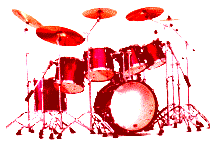 School of Drums
School of Drums
But don't let it frighten you. This is easy to learn if we approach it correctly! BASIC DANCE BEAT #1: 16th 4/4 as we studied it in the Basic Dance beats lesson,
is the MOST BASIC and the SIMPLEST form of the rhythm, but there are 4,297,967,295 other ways to alter it. That's the bad news! That's right! We need to get the old creative-juices flowing and JAM (or experiment) with this
rhythm structure. We'll do it the same way most of you have probably already been jamming with
the 8th 4/4 'Rock' beat ( Dancebeat #3). Once we get a couple of variations cooking, the rest will flow as a matter
of intuitive thinking. Remember this! Any change we make to the basic pattern as we repeat it over
and over, officially becomes one of the 4.3 billion possible variations, provided we maintain the 16th
note feel on the Hi-hat or Ride cymbal. We will need to maintain the backbeat flow (that's the consistent snare
on the counts of 2 ad 4), but any additional bass or snare notes we add or subtract to the mix, will represent variations
(or permutations) of the beat pattern.
HAVE FUN WITH IT! Use your great imagination.
However; I should also add that this beat structure isn't exclusive to Rap and Hip-Hop styles. You will be using it
in all forms of popular music from jazz to pop-ballads and Country-Western music styles as well. To simplify this problem, start
with the easiest variations of 16th 4/4 first, and gradually try to continually inject, alter and add, increasingly
complex variations to the mix, as the repetitions of the pattern continue to consistently cycle. It's a
life-long project to accumulate and master as many variations of this beat structure as we possibly can! The more we experiment with it,
the more we'll discover.
TIP:
ANOTHER TIP: I will provide a few very simple example patterns in this lesson plan.
Hopefully, this will be enough to get you started. You will be on your
own from that point on to JAM, imagine and create with this structure every day . . . always
seeking out different and more interesting ideas. UNDERSTANDING EXACTLY THE WAY Then; JAM! Gradually we will build an arsenal of our own personal favorite ideas, thus forming a personalized drum solo
within the beat-framework or beat-structure in focus. From there, we learn to apply a few
rolls or fills and immediately our jam will take on a very professional and polished
sound. Very soon we'll begin to recognize these same ideas within the music
we hear around us everyday, and it will be very easy to analyze and then play along with
any those songs. Actually, the music we listen to, will play a large part in the
learning process, because with so many rhythmic choices, we're sure to
hear many new and different ideas that are similar to, but unlike our own.
It'll be easy to mimic and acquire those beats, by ear.
Sometimes we can alter the entire 'feel' of a rhythm, by simply omitting
or adding just one note on the bass or snare.
NOTE: The hi-hat notes may be played on the ride cymbal if you prefer . . . Get the basic 16th 4/4 pattern flowing . . . keep it going for several repetitions
as a steady rhythm, then try to change it up by altering the bass or snare as in
the following examples . . . EXAMPLE A: POPUP BLOCKERS will not allow the video to appear or play. Be sure to DISABLE your popup blocker. The above
video version is designed for Internet Explorer using Windows Media Player. Video: For almost all handheld devices and other browsers.
Video: For almost all handheld devices and other browsers. EXAMPLE C:
Video: For almost all handheld devices and other browsers. Are you getting the idea? GO GET 'EM! You will never run out of new ideas. Therefore, you should
never allow yourself to become embedded in a rut when improvising with this structure.
If you catch yourself falling into a rut, playing the same old rhythms over
and over, then get the creative juices flowing! You must use your own imagination! If necessary,
get out the old pen and some paper, then write and study a few new and different possibilities
note for note, and add them to the mix. I hate rules but there are a couple we need to keep in mind when jamming with this structure. Well, that's it, for this lesson! However, another lesson may be necessary to explain how fills and rolling techniques
are altered within this rhythm structure. Stated very simply . . . Most of the same fills we've used with 8th 4/4 will work here too. Sometimes, we may need
to double the length of the fill to make it fit the slower tempo of the beat, or we'll need to cut the
speed of the fill to a point where it'll seem very draggy and slow. To help prepare you for playing interesting fills with 16th 4/4, it may be best to make certain you can play the
following two rolls at a very rapid clip, than adapt them to the 16th 4/4 beat pattern. MEMORIZE THIS ROLL PATTERN: 32ND SINGLES:
Below we have a half measure of 32nd singles. This fill
will eventually become one of your favorites. The last note(s) in the pattern are a
simultaneous bass and hi-hat. Be sure to play those last two notes as you practice. It
will make the next step easier. This is the way 32nd singles will sound when used with a slow 16th rock beat (below). 16TH TRIPLETS:
6 notes on the snare for every bass note.
Now play two repetitions of the roll . . . six notes on the snare then six more on the hi tom. When you can play a half measure 16th triplet fill with ease, proceed into a 16th rock beat,
in the same way we studied the 32nd single roll above. You now have two different fills that may be used with 16th rock. Musical Time - Finite to Infinity: Finite to Infinity: Discover the (lost) 500 year-old enigmatic secrets hidden within
the current time-signature system. Seven short mesmerizing and easy-to-follow lessons will lead you quickly and easily towards
(musical-time) guru status. You will learn to visualize (read, write or feel) the existence This should lead
directly to the e-book. This very informative little booklet will amaze you
with hundreds of valuable tips and insider secrets! HOW TO: Purchase old/used drumsets for pennies and resell them for decent
profits.
![]()
![]() 16TH 4/4 Variations
16TH 4/4 Variations
![]()
![]()
Think about this . . .
Within ANY measure of ANY 16th 4/4 song, we'll be faced with 4.3 billion
potential choices as to what variation of the rhythm we may want or need to play. Think
about that for a very long moment! It is an awesome thought, but true.
The good news is the fact that (collectively) all drummers around the world are actually only using 60 to 80 of those potential 4.3 billion variation
possibilities. The best, easiest and fastest way to get a handle on 16th 4/4 is to stimulate the imagination as we play, jam and improvise with the
basic form of the beat. Then, as we repeat the basic beat, it gets a little boring. That's a good thing! At that point we realize it's pretty easy
to begin altering the (bass drum and snare) rhythms a little with each new repetition of the beat. Soon after that, the boredom turns to absolute
pleasure as we begin creating what seems to be dozens of our own interpretations of the beat pattern.
The fact that there are so many potential variations (or permutations )
to choose from, tends to make it difficult to know WHERE to start. At the same time, anything we alter
or change is okay, as long as we never lose the feel of the repeating backbeats. Rap and Hip Hop music styles are
based heavily on this beat structure and its many potential variation possibilities.
It is also productive to listen to an endless array of 16th 4/4 songs, then imitate the rhythms
we're hearing within that music. Doing so will accelerate your learning curve exponentially. Your
ears will work wonders, if you'll give them a chance. Do it! Learning this way is easy to do, if
our ears are totally focused on the various drummers (within the recordings). It's the natural way
to learn.
Also; play around with the 16th 4/4 notation on paper. Layout 16 notes, (as X's) on the
hat, and examine the rhythmic possibilities (or options) between the bass and snare. It'll
be wise to keep the basses on the counts of 1 and 3, and the snares on 2 and 4,
in the beginning. After that . . . almost anything we add or subtract to the pattern,
will be an interesting rhythm.
4.3 billion is an awesome number! For example, if you were to
begin at birth to hear one new beat every second (24 hours per day/7 days
per week) . . . It would take 32 years to hear the first billion beat
variations of 16th 4/4. You would need to live 132 years and do nothing
else for your entire life, just to hear them all one time each. Forget about trying to learn
them all! All drummers, (collectively) actually use only around 70 or 80
of the easiest of these beat permutations. Learning to use all of them is
a virtual impossibility. There simply aren't enough years in one lifetime to do it.
PERMUTATIONS WORK, WILL HELP IMMENSELY.
Jamming is a fun, easy, way to practice, and I think that far too
many drum instructors tend to ignore this fundamental streamlined method of study.
As we jam and hit on ideas that cook, we will tend to remember those
ideas and return to them on each new practice session. ![]() Learn to jam with 16th 4/4 . . .
Learn to jam with 16th 4/4 . . .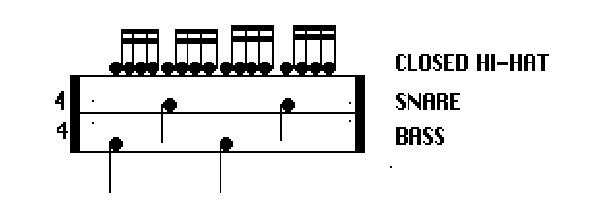
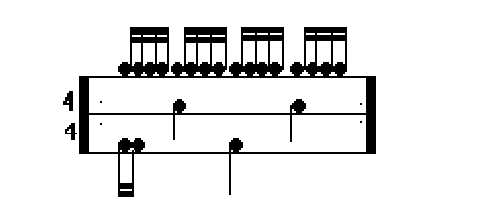
![]() VIDEO: Click here to 'Play', see, and hear the
16th rock variation video.
VIDEO: Click here to 'Play', see, and hear the
16th rock variation video.
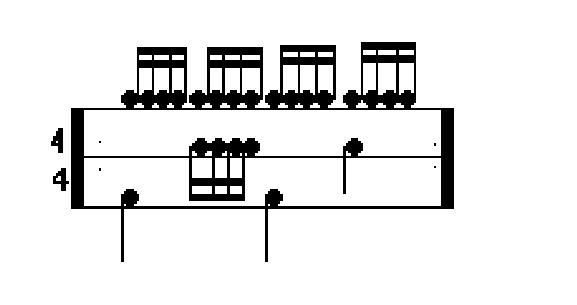
![]() VIDEO: Click here to 'Play', see, and hear the 16th rock
variation video. (Designed for IE using Win media Player.)
VIDEO: Click here to 'Play', see, and hear the 16th rock
variation video. (Designed for IE using Win media Player.)
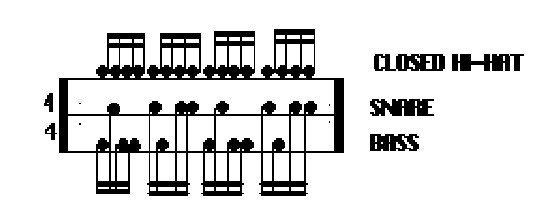
![]() VIDEO: Click here to 'Play', see, and hear the
16th rock variation video. (Designed for IE using win Media Player.)
VIDEO: Click here to 'Play', see, and hear the
16th rock variation video. (Designed for IE using win Media Player.)
Remember! You are looking at only three suggestions here. That last idea was a paradiddle between the snare and the bass.
There are still 4,297,967,292 other ideas to choose from. Get your imagination in gear and put a fire under those creative juices.![]() RULES:
RULES:
Practice this roll, 'rapid fire' and repetitiously, allowing no pause between repetitions.
Keep it going for long durations while away from the drumset. You'll need to build
coordination and speed, before adding it to the 16th rock beat.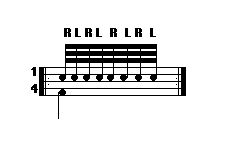
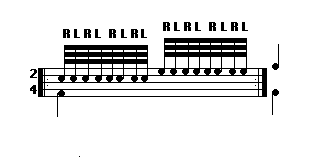
![]() Hear the fill as it should sound.
Hear the fill as it should sound.
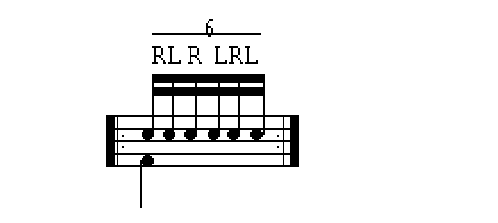
![]() Now, hear all the 16th 4/4 variations (above)
with a 32nd single fill.
Now, hear all the 16th 4/4 variations (above)
with a 32nd single fill.
 Back to the lesson menu:
Back to the lesson menu:
![]() Copyright Bill Powelson 1965-1994-2008-2014 @ all rights reserved.
Copyright Bill Powelson 1965-1994-2008-2014 @ all rights reserved.
![]()
![]()
Cool Drum Solos.
Video Drum Solo Lessons Free

Drum Solo Video: Click to 'LEARN' Watch and Learn Now! PLAY Great Drum Solos within hours (not years).
NEW 'Subliminal Method' teaches drum solo techniques PAINLESSLY!
Master rudiments 'NATURALLY' without boring regimentation or serious discipline.
Listen, watch and PLAY your way to awesome drum solos (and polished rudiments) BY SIMPLY HAVING FUN. . . . It works, folks!
Don't be a skeptic until you at least try it first. You owe it to yourself toTRY IT RIGHT NOW!
![]()
![]()
Membership Includes
EVERYTHING FREE! All the E-book icons are "hot" here at the password site. Click an e-book icon and go directly to the product.
Bill Powelson's Other Drumming Courses
![]()
